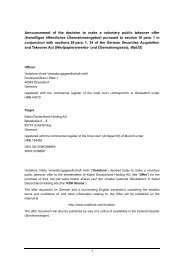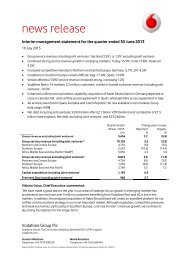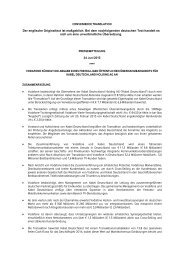Create successful ePaper yourself
Turn your PDF publications into a flip-book with our unique Google optimized e-Paper software.
Moving the debate forward • The Policy Paper Series • Number 8 • April 2008<br />
& King. 22 Furthermore, Figure 7 shows Carter & Wright’s result<br />
that with asymmetry greater than 67/33 the smaller network<br />
also prefers cost-based reciprocal access. In this case the<br />
loss of market share for the smaller firm from varying access<br />
charges from cost outweighs the benefit the smaller network<br />
gets from profits on interconnection.<br />
Figure 7: The effect of access on profits with<br />
significant asymmetry<br />
Market share (100% = access at cost)<br />
100.5%<br />
100.0%<br />
99.5%<br />
99.0%<br />
Large Firm Small Firm<br />
98.5%<br />
60% 70% 80% 90% 100% 110% 120% 130% 140%<br />
Access Charge as % of Cost<br />
Source: Frontier model<br />
These results strongly suggest that the effect of asymmetry<br />
between networks on equilibrium access charges is extremely<br />
small compared to the impact of on-net/off-net differentials.<br />
The possibility of foreclosure in the Carter & Wright model<br />
In the context of suspicions of the use of high access charges<br />
for predation whether, under Carter & Wright’s model, a large<br />
operator could increase its market share by driving up (or<br />
down) the reciprocal access charges (which it might arguably<br />
be able to do as a result of greater bargaining power). In Figure<br />
5 I have already shown that setting the reciprocal access<br />
charge either above or below cost can reduce the smaller<br />
network’s market share. Figure 8 below shows the equivalent<br />
market share figures for the larger network under the more<br />
extreme assumption of asymmetry.<br />
Figure 8: Effect of different levels of access charge<br />
on larger operator’s market share<br />
Market share (100% = access at cost)<br />
83.60%<br />
83.55%<br />
83.50%<br />
83.45%<br />
83.40%<br />
83.35%<br />
83.30%<br />
83.25%<br />
83.20%<br />
60% 70% 80% 90% 100% 110% 120% 130% 140%<br />
Access Charge as % of Cost<br />
Source: Frontier model<br />
This demonstrates clearly that varying the access charge has<br />
a very small impact on the larger network’s market share,<br />
even when the initial asymmetry is great. Furthermore, its<br />
market share is not strictly increasing with the access charge,<br />
rather it is minimised at the profit maximising point.<br />
On-net Pricing in Mobile<br />
Further sensitivity tests with the model indicate that given<br />
an initial asymmetry of 95/5, setting an access charge of<br />
twice cost would only increase the larger network’s market<br />
share from 95% to 96%. To put this in context as a credible<br />
strategy for foreclosure, the larger network could achieve the<br />
equivalent increase in equilibrium market share by reducing<br />
rental charges by 1% relative to their profit maximising level.<br />
I have also tested this result for different values of the<br />
parameter that determines the intensity of inter-network<br />
competition and conclude that for values that allow an<br />
equilibrium to exist 23 the impact of the access charge on<br />
market share under this model is very small indeed.<br />
I conclude therefore that exploration of Carter & Wright’s<br />
model, adding network asymmetry, provides no support for<br />
the suggestion that forcing up reciprocal access charges<br />
could be advantageous to a larger network as part of a<br />
foreclosure strategy.<br />
Network asymmetry in the presence of<br />
on-net/off-net differentials<br />
In my earlier analysis I showed that on-net/off-net<br />
differentials mean that symmetric networks can jointly<br />
profit maximise by setting a low reciprocal access charge,<br />
possibly adopting a bill and keep arrangement.<br />
I am interested in analysing how the network asymmetry<br />
modelled by Carter & Wright might affect the findings in the<br />
presence of network-based price discrimination. I am not<br />
aware of any published paper covering this topic, and the<br />
outcomes are mathematically complex. As a consequence,<br />
Frontier’s model is an ideal tool for examining this scenario.<br />
We have seen that Carter & Wright’s work suggests that<br />
asymmetry should strengthen the preference of a larger<br />
network for cost-based access charges. I would expect this<br />
effect to carry over into a world with price differentials,<br />
but would expect it to be swamped by the greater effect<br />
of TMNEs. I would expect the large network to retain its<br />
interest in bill and keep, because of the impact of TMNEs on<br />
competition at the margin described above. However, because<br />
positive TMNEs will tend to favour larger networks I would<br />
expect the profits of the larger network to be less sensitive to<br />
the access charge than in the symmetric case, while I would<br />
also expect the smaller network’s profits to be more sensitive<br />
than in the symmetric case.<br />
The impact of different levels of reciprocal access charges on<br />
profits is shown in Figure 9. In this figure and those following I<br />
have assumed the more extreme example of asymmetry used<br />
earlier, that is an 83/17 split at cost-based access charges. 24<br />
Figure 9 confirms expectations.<br />
17

















